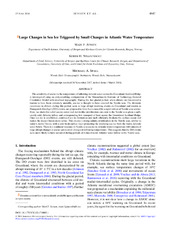Large changes in sea ice triggered by small changes in Atlantic water temperature
Peer reviewed, Journal article
Published version

Åpne
Permanent lenke
https://hdl.handle.net/1956/19009Utgivelsesdato
2018-06Metadata
Vis full innførselSamlinger
- Department of Earth Science [1050]
Originalversjon
https://doi.org/10.1175/jcli-d-17-0802.1Sammendrag
The sensitivity of sea ice to the temperature of inflowing Atlantic water across the Greenland–Scotland Ridge is investigated using an eddy-resolving configuration of the Massachusetts Institute of Technology General Circulation Model with idealized topography. During the last glacial period, when climate on Greenland is known to have been extremely unstable, sea ice is thought to have covered the Nordic seas. The dramatic excursions in climate during this period, seen as large abrupt warming events on Greenland and known as Dansgaard–Oeschger (DO) events, are proposed to have been caused by a rapid retreat of Nordic seas sea ice. Here, we show that a full sea ice cover and Arctic-like stratification can exist in the Nordic seas given a sufficiently cold Atlantic inflow and corresponding low transport of heat across the Greenland–Scotland Ridge. Once sea ice is established, continued sea ice formation and melt efficiently freshens the surface ocean and makes the deeper layers more saline. This creates a strong salinity stratification in the Nordic seas, similar to today’s Arctic Ocean, with a cold fresh surface layer protecting the overlying sea ice from the warm Atlantic water below. There is a nonlinear response in Nordic seas sea ice to Atlantic water temperature with simulated large abrupt changes in sea ice given small changes in inflowing temperature. This suggests that the DO events were more likely to have occurred during periods of reduced warm Atlantic water inflow to the Nordic seas.